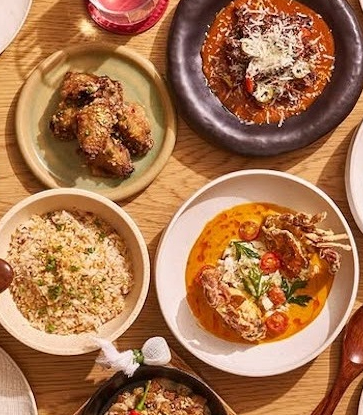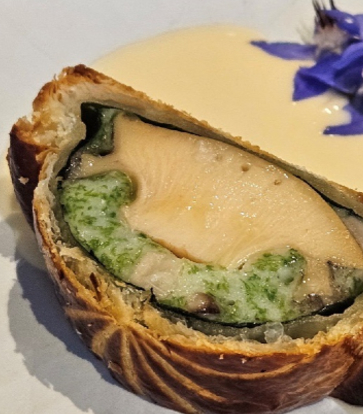A slew of local chefs in their 30s who helm one-MICHELIN-starred restaurants here have also gained more prominence on the global dining stage, from participating in four-hands collaborations to fronting international food events. Han Liguang of Labyrinth has become the poster boy of sorts for locally sourced produce, Jason Tan of Corner House is known for his vegetable-centric “gastro-botanica” cuisine, while Malcolm Lee of Candlenut is widely hailed as the brains behind the world’s first MICHELIN-starred Peranakan restaurant.
Besides this up-and-coming batch, a number of Singaporean chefs have been quietly flying the Singapore flag in MICHELIN-listed restaurants overseas, from New York to Hong Kong, London to Oslo — away from the spotlight of the annual launch of the MICHELIN Guide back at home.

These Singaporean chefs include Nicholas Tang, executive chef of MICHELIN Plate restaurant DBGB in Washington D.C., a casual French American bistro by renowned French chef Daniel Boulud, and Barry Quek, executive chef of Beet, a modern European restaurant in Hong Kong with a MICHELIN Plate recognition. Over in Norway, Mathew Leong, who was crowned the champion of this year’s Bocuse d’Or Singapore Selection, is the sous chef of A L’aise, a MICHELIN Plate restaurant in Oslo.
Other names include Max Ng, head chef of Momofuku Ssäm Bar in New York City, which has also been recognised with a Bib Gourmand, and Andrew Yeo, corporate executive chef of modern Chinese restaurant group Hakkasan, which runs two London outlets with one MICHELIN star each and a New York outlet with a MICHELIN Plate.

Singapore Pride
Getting a shot at doing Singapore proud is Leong, who has spent 1½ years working in Restaurant À L’aise in Oslo, which serves classic French cuisine with in-season Norwegian ingredients by chef Ulrik Jepsen. He will represent Singapore in the Asia-Pacific selection of the Bocuse d'Or, a biennial world chef championship that is named after the legendary French chef, Paul Bocuse. The selection will be held in Guangzhou in 2020 ahead of the finals in Lyon in 2021.
The 25-year-old says: “Participating in Bocuse d’Or has always been a dream for me as I’ve been inspired by the work of past winners such as chefs Geir Skeie and Rasmus Kofoed. I have always dreamed of being the first youngest Asian chef to stand on the podium with the culinary giants.” Leong has spent three years of training in hopes of taking part in the Bocuse d’Or finals.
Besides representing Singapore in culinary competitions, other chefs have been introducing a slice of Singapore in their menus. For the past four years, chef Tang of DBGB in the Washington D.C. has been organising a series of popular Singapore-themed dining events during the month of August to commemorate Singapore’s National Day, which falls on 9 August. Come 22 August, DBGB will hold a Singapore Crab dinner, which combines Singapore’s love for crabs with the American tradition of having seafood boils. On the menu will be Maryland crabs — done in chilli crab and country boil styles, Tiger Beer and Singapore Sling-inspired cocktails.
Other Singapore-themed dinners that Tang has done featured dishes including sambal stingray, oyster omelette, satay, kueh pie tee, chicken rice and kaya profiteroles. Some of these past dining events, which attract a good mix of Singapore citizens living overseas and Americans, were sold-out within 24 hours.
READ ALSO: Top Singapore Chefs Reveal Spots For Comfort Food

In April, he introduced the Singapore Ice Cream Sandwich (right), which is inspired by his childhood memories, for a dining promotion.
Tang, who has been based in the United States for the past six years, says: “I like to tell the Singapore story and share my childhood memories through food.”
One of the Asian-inspired dishes that he has created is the X.O. duck, which is inspired by duck rice. The dish has fried rice cooked with duck confit X.O. sauce-infused fried rice served with ginger-glazed duck breast.
Next on Tang’s to-cook list is Hokkien mee. “It is almost like a pasta dish and has a ‘wow’ factor with pork lard, seafood and chillies.”

For Quek in Hong Kong (left), Singapore dishes might not gel with Beet Restaurant’s direction, which showcases modern European cuisine with a strong focus on seasonal and locally sourced ingredients at its peak.
However, he sneaks in a local dish or two through desserts. Items include pandan ice-cream and putu piring (steamed rice cakes), which stirs up his memories of visiting pasar malams (street bazaars). He says with a laugh: “I add local items to the menu whenever I miss home.”
Chefs whom the MICHELIN Guide Digital spoke to shared that they left Singapore in search of a more diverse and wider scope of culinary experiences.
For Tang, the opportunity to work as a sous chef in the one-MICHELIN-starred Cafe Boulud in New York City in 2013 came about after he worked in db Bistro Moderne in Marina Bay Sands for three years. Prior to this, the 34-year-old had worked for chef Emmanuel Stroobant, who runs the one-MICHELIN-starred Saint Pierre, before training at Le Cordon Bleu in London.
After he married his American wife Traci in 2013, Tang was asked by chef Daniel Boulud if he wanted to cook in one of his restaurants in the United States. Then 28, Tang gamely took up the relocation opportunity, which was also his debut trip to the Big Apple. He says: “Being a young cook then, I had the desire to experience something different and was excited about New York life as the city is one of the dining capitals of the world.”
Starting his US cooking career at Cafe Boulud, he recalls that he had to work harder to prove himself to the kitchen staff. Back then, he says that it was uncommon for an Asian to cook French cuisine there. He recalls: “People were wondering who was this guy who could come in as a sous chef and wanted to test me out.”
He also had to overcome communication barriers with a mainly Hispanic kitchen staff who spoke Spanish and gradually picked up the language.

Working With Local Produce
One of Tang’s biggest takeaways from working in the US is his exposure to fresh seasonal ingredients and the harvesting patterns of farmers. He visits the Union Square Greenmarket to source for fresh produce regularly. He says: “I started to create dishes and recipes that focus on the ingredients, through putting less on the plate and letting the quality of the produce speak for itself.”
It is ditto for Leong of Restaurant A’laise, who spent the last 2½ years working in Norway. He had spent a year at one-MICHELIN-starred restaurant RE-NAA in Stavanger. On his decision to relocate halfway around the world, the SHATEC graduate says: “Norway is a dream place to cook as it has one of the best produce in the world, from both the land and sea. Through my time in Norway, I’ve fallen in love with the country and its beautiful nature and produce.” Prior to his move to Norway, Leong worked in hotel chains and restaurants including Tippling Club and FiSK.
Exposure to local produce was also what Quek of Beet Restaurant gained when he relocated to Hong Kong close to two years ago to helm the restaurant. About 95% of its ingredients are sourced from farms in the Hong Kong countryside, such as chicken, pork, honey, fruit and organic vegetables. The restaurant is by the Les Amis Group, whose flagship is Les Amis, a two-MICHELIN-starred French restaurant in Singapore.
Some of the produce include pork, marigold, lemon balm and strawberries from the New Territories. To highlight the farm connection, the restaurant is named after the humble earthy root vegetable.
Quek plunged himself into the farming world and got his fingers dirty, from visiting farms and networking with farmers to organising the logistics of vegetable delivery. The 31-year-old says: “I had thought that Hong Kong is just a city for shopping and eating, just like Singapore. However, I was so intrigued by the quantity of organic farms in Hong Kong.”
Working with local ingredients means that he also had to grapple with the typhoon season, which is typically from late June to September. This results in produce getting blown away or damaged. The drastic change in weather conditions meant that he had to adapt the menu to the reduced amount and variety of ingredients.

After working at top French restaurants, Quek was keen to put his days of cooking classic French cuisine behind and sought to broaden his cooking horizons in order to carve out his culinary identity. At 25, he packed his knives and took his debut Europe trip to stage in the now-defunct MICHELIN-starred modern European restaurant De Wulf in Belgium.
He recalls: “I learnt so much at De Wulf, from butchering whole animals to foraging for fresh plants and herbs just 30 minutes before service.”
He moved on to popular Australian restaurant Attica in Melbourne, where he learnt about the importance of fostering close relationships with farmers and producers, before working in one-MICHELIN-starred Portland and its sister restaurant Clipstone for two years. It was during his stints in Europe that he picked up a love for fermenting and pickling ingredients.
These days, he does it with Asian ingredients such as miso and barley, in the form of seasoning and condiments to inject umami into his dishes at Beet Restaurant. After a few years of working overseas, he decided to take up an opportunity to helm Beet Restaurant in Hong Kong, which is closer to home.

One of Quek’s biggest takeaways from his overseas work stints is getting exposed to a vastly different work culture — both inside and outside of the kitchen.
His first job was at Joel Robuchon Restaurant, which he says was “very military-like”. He shares: “There was only one way of doing things, which was the ‘Joel Robuchon’ way, from cutting vegetables and butter to folding table cloths. It was the most intense kitchen that I’ve worked in, from the constant shouting from the chefs to plates being thrown around by the head chef.”
Working in this rigorous and stressful environment, Quek and most of his colleagues did not talk to each other in the kitchen. However, his stints in Europe changed his perspective. He says: “Kitchen staff talked during service time without affecting the quality of work and there was a greater emphasis on work-life balance, in which people knew their colleagues on a personal basis.
“I changed a lot — from someone who didn’t talk to my teammates in the kitchen to taking a whole new open approach to interact with people around me,” he adds with a laugh.
For Leong in Norway, he had to adapt to a different culture and language that was used in the kitchens in Norway. He shares that people in Norway were shocked to find out that a Singaporean is working there.
He adds: “Working overseas has helped me to get out of your comfort zone and to be independent by adapting to the environment. I have met so many people around the world with different styles of cooking. For me, this is something I would never have experienced if I had remained in Singapore.”

Growing up in Singapore, Tang (right) fondly remembers scrumptious meals whipped up by his paternal and maternal grandmothers at home. He recalls: “Weekends were meant for big family feasts. My Cantonese grandmother was known for her soups, while my Hokkien grandmother whipped up stir-fries and fried fish.” This ardent love for food persisted even after he graduated with a Bachelor’s Degree in sports management and the calling to work in the kitchen beckoned.
Inspired by his childhood trips to the wet market, he says: “I like being a chef as I can showcase the produce and share the farmers’ stories behind the ingredients with diners.”
These days, Tang, who is a father of two young children, returns to Singapore once every two years to visit his family.
For Quek, the long list of dishes he misses include char kway teow, laksa and nasi lemak. He adds that it is now easy to get decent chicken rice in Hong Kong, with the opening of an outpost of the popular Tian Tian Hainanese Chicken Rice there last year.
Leong, who flies home twice a year, misses satay, chicken rice and his mother’s cooking, though he is constantly on the hunt for Asian restaurants in Oslo to satisfy his craving.

The Way Home
Despite living overseas for the past few years, these chefs keep close tabs on the Singapore dining scene through their friends in the close-knit F&B industry and social media. Tang says: “Since the MICHELIN Guide came to Singapore, it has put the country on the dining map and showcases what we can offer.”
When asked if he has plans to move back to Singapore for work eventually, the American permanent citizen says he plans to settle down in the US for now. He says: “Cooking French cuisine in Singapore might be tougher, as competition there is higher. I think it is easier to tell the Singapore story, which I am most familiar with, through my food in the US.”
On the other hand, Quek, who visits Singapore every four months for work, plans to return to Singapore to work in the next three to four years, in order to be closer with his family.
He says: “The dining scene in Singapore has matured so much, compared to when I first left Singapore. More people are dining out and there are more approachable restaurants with quality food that are outside the world of fine dining.” And we can hardly wait as homecoming beckons.
READ ALSO: Les Amis Group: Grooming Singapore's Top Culinary Talents






















